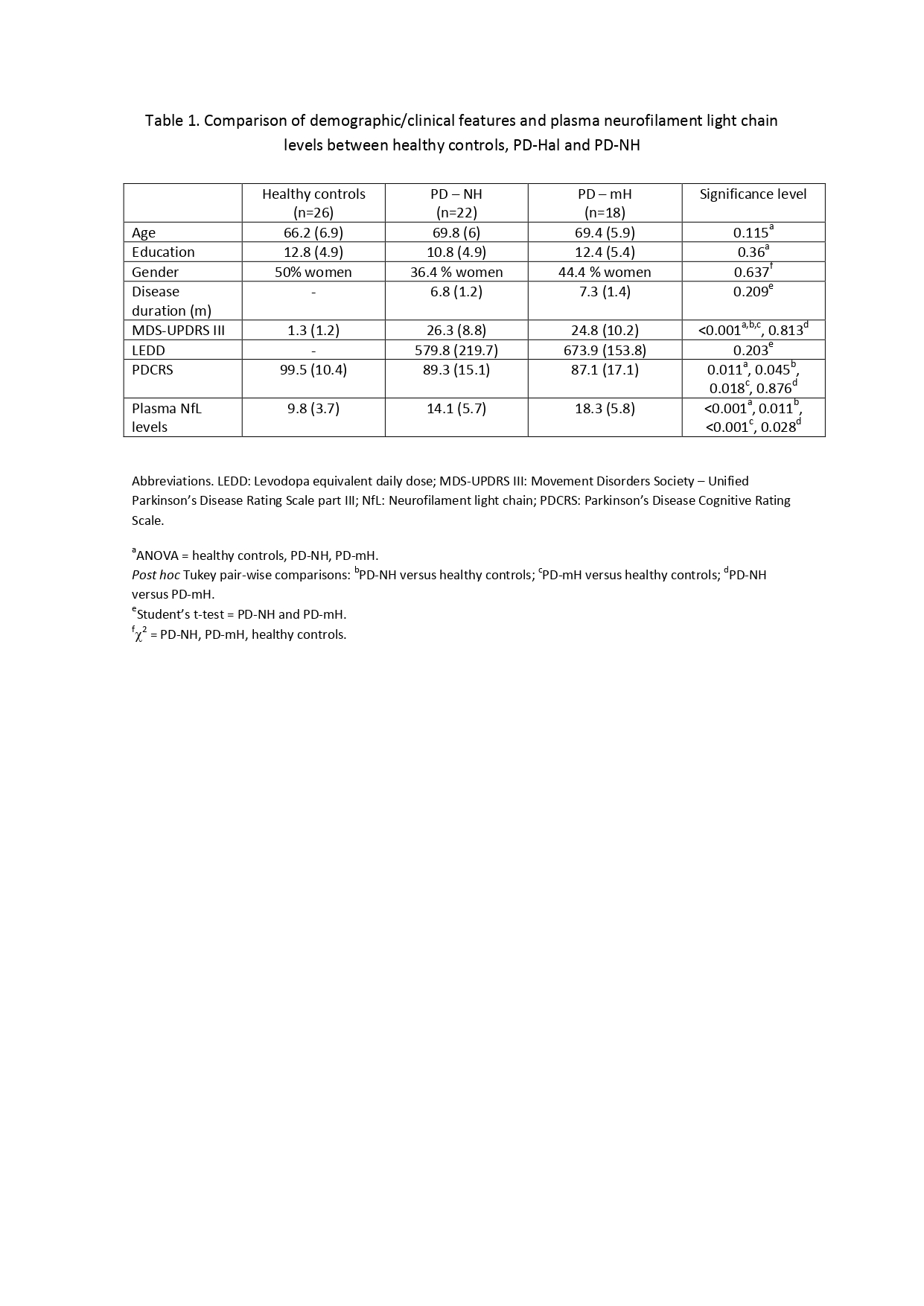Objective: To examine whether patients with Parkinson’s disease (PD) and isolated minor hallucinations have increased plasma neurofilament light chain (NfL) levels and/or differences in white matter integrity with respect to PD patients without hallucinations.
Background: Although there is a clear association between well-structured hallucinations in PD and poor prognosis, less is known about the prognostic implications of psychosis in early stages. Previous studies have found an association between the presence of minor hallucinations and more severe cortical atrophy1, but knowledge on subcortical damage in white-matter tracts is limited. Neurofilament light chain (NfL) is released as a result of neuroaxonal damage and it has been proposed as a predictive marker of PD severity and progression2. Diffusion tensor imaging (DTI) has demonstrated utility to detect white matter (WM) integrity alterations in PD and other neurodegenerative diseases.
Method: This cross-sectional study enrolled 64 participants, including 40 non-demented PD patients (PD-NH, n=22 without hallucinations; PD-mH, n=18 with minor hallucinations), and 24 healthy controls. Plasma NfL was measured with the Simoa Human NF-light Advantage kit using the Single Molecule Array technology. We also investigated the existence of WM integrity differences across groups in terms of average fractional anisotropy values in a subset of major cerebral WM tracts.
Results: Groups did not differ in age, gender or education. Both PD groups were also comparable in disease duration, motor status, levodopa dosage and cognition. Plasma NfL levels were significantly higher in the PD-mH group than in the PD-NH and healthy groups (18.3 ± 5.8, 14.1 ± 5.7, and 9.8 ± 3.7 pg/mL, respectively, p < 0.001). Partial correlations controlling for age, education, gender and evolution showed lower FA values in the left inferior longitudinal fasciculus (LILF) in the PD-mH group relative to the PD-NH group (r= -0.537; p=0.032). Higher NfL levels were significantly associated with lower DTI FA in the LILF (r= -0.47; p=0.036).
Conclusion: Minor hallucinations in PD are associated with higher plasma NfL levels and greater disruption of one of the major occipitotemporal association tracts. Our results suggest that minor hallucinations should be considered as a potential clinical marker of increased neurodegeneration.
References: 1. Bejr-kasem H, Pagonabarraga J, Martínez-horta S, Pérez-pérez J, Angeles M, Pascual-sedano B, et al. Disruption of the Default Mode Network and Its Intrinsic Functional Connectivity Underlies Minor Hallucinations in Parkinson’s Disease. Mov Disord. 2019 Jan;34(1):78-86. 2. Chin-Hsien Lin, Cheng-Hsuan Li, Kai-Chien Yang, et al. Blood NfL: a biomarker for disease severity and progression in Parkinson disease. Neurology. https://doi.org/10.1212/WNL.0000000000008088 (2019)
To cite this abstract in AMA style:
H. Bejr-kasem, J. Pagonabarraga, F. Sampedro, S. Martínez-Horta, R. Perez-Gonzalez, J. Marín-Lahoz, A. Horta-Barba, I. Aracil-Bolaños, A. Campolongo, C. Izquierdo, J. Perez-Perez, B. Pascual-Sedano, J. Kulisevsky. Minor hallucinations in Parkinson’s disease are associated with increased neurofilament plasma levels and reduced white-matter integrity in the inferior longitudinal fasciculus [abstract]. Mov Disord. 2020; 35 (suppl 1). https://www.mdsabstracts.org/abstract/minor-hallucinations-in-parkinsons-disease-are-associated-with-increased-neurofilament-plasma-levels-and-reduced-white-matter-integrity-in-the-inferior-longitudinal-fasciculus/. Accessed December 8, 2025.« Back to MDS Virtual Congress 2020
MDS Abstracts - https://www.mdsabstracts.org/abstract/minor-hallucinations-in-parkinsons-disease-are-associated-with-increased-neurofilament-plasma-levels-and-reduced-white-matter-integrity-in-the-inferior-longitudinal-fasciculus/

